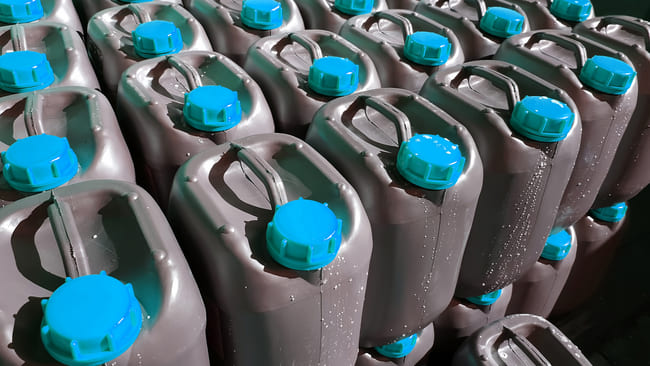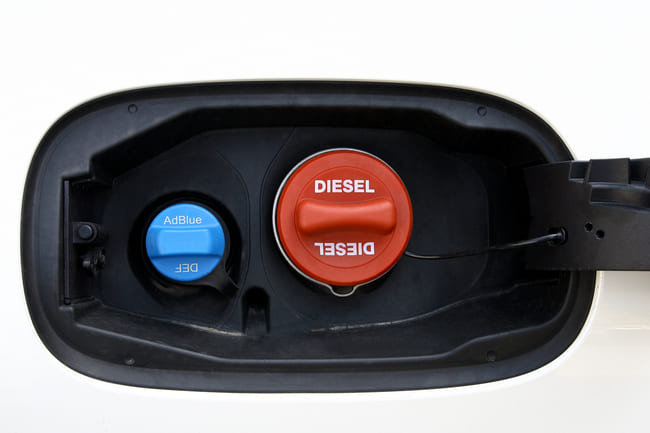
Without AdBlue, diesel vehicles would have many times more harmful exhaust gases, exactly taken nitrogen oxides, emit. In view of the increasing requirements of new EU emission standards such as the Euro 6 standard, AdBlue is therefore indispensable. But what is behind this urea? How exactly does urea work and what about the practical application and the costs? You can find out more about this in the following article.
background
AdBlue is the trade name for the urea solution “Aqueous Urea Solution 32”, abbreviated to “AUS 32”, and is a registered trademark of the German Association of the Automotive Industry (VDA). In summary, it is a reducing agent used in exhaust aftertreatment, which is based on the pollutant control system known as “selective catalytic reduction” (SCR). Along with oxidation catalytic converters and particulate filters, SCR technology is one of the devices used to reduce pollutants in diesel vehicles and is part of the effort to stay below the emission limits applicable in Europe. In particular, the current Euro 6 emission standard places high demands on the emission reduction with a maximum nitrogen oxide emission of 80 mg per kilometer.
Function and Use
The aqueous urea solution, AdBlue, is produced from ammonia and carbon dioxide by means of a chemical reaction. If this solution is now sprayed into the exhaust gas flow, the SCR catalytic converter behind it decomposes it from an exhaust gas temperature of 170 degrees, with the nitrogen oxides (NOx) being converted into harmless nitrogen and water vapor by the ammonia that is produced. In this way, nitrogen oxide emissions are reduced by up to 90 percent.
The quality requirements for AdBlue are regulated in the ISO standard 22241, which replaces the DIN standard 70700. This SCR technology has been used in trucks for a long time. In passenger cars, SCR devices have been widespread since the Euro 6 standard of 2014 with an even more extensive reduction in nitrogen oxide emissions. There are no quality differences between AdBlue for cars and AdBlue for trucks. On the other hand, NOx storage catalytic converters are used in smaller vehicles with the Euro 6 standard.
Costs

Apart from petrol stations and garages, AdBlue is also available from retail outlets, such as hardware stores, car accessories shops and occasionally discounters. Prices range from less than 1 to 4 euros per liter, with costs falling as the quantity purchased increases. AdBlue is sold in bottles, canisters and larger containers. These should be marked with the ISO standard 22241.
Application

AdBlue is filled into an additional tank on the car, which, like petrol, has to be topped up regularly. Similar to the petrol tank, the AdBlue tank is also electronically controlled, but it is not given in the form of litres, but as the vehicle's remaining range. When the filling level is low, the first indication is given as standard at a remaining range of 2,400 kilometers and the next prompts to top up at 1,600 and 1,000 kilometers. If the AdBlue tank is empty, the engine can no longer be switched on due to excessive environmental pollution or only emergency operation is possible. Just like the fuel consumption, the consumption of AdBlue also depends on your own driving style and various factors such as the vehicle weight. According to the VDA, this averages 0.2 liters per 100 kilometers. One AdBlue filling can cover a distance of 5,000 to 15,000 kilometers, for example.
The filler neck of the auxiliary tank is usually located in the trunk or next to the fuel tank. Usually, the topping up is done by the workshop as part of the regular inspections and should be sufficient until the next inspection, provided that the car is not driven excessively. If the amount refilled by the workshop is not sufficient, drivers can easily refill it themselves. Do-it-yourself petrol pumps were and are often only for trucks (from Euro 4 standard) that have SCR devices and AdBlue tanks. However, some gas stations now also offer tank systems for cars that can be found via search engines and apps. The AdBlue tank must not be confused with the petrol tank, since incorrect refueling and switching on the engine will result in serious engine damage. However, accidental filling of the AdBlue tank with petrol through the filling hose is unlikely, since the filler neck of the AdBlue tank is smaller than that of the petrol tank. You should only pay close attention to this when filling with canisters and bottles. So-called refill kits are also available for new car models that have AdBlue dosing systems. In addition to AdBlue dosing bottles, these include special adapters or tank nozzles that make filling up with AdBlue easier.
As far as storage is concerned, the function of AdBlue can only be maintained at temperatures between -11 and 30 degrees. So stocks of AdBlue should not be stored in extreme cold, otherwise it will freeze. For this reason, the AdBlue dosing system is also heated, which is controlled by the on-board electronics. If stored properly, the shelf life is at least 12 months.
AdBlue is non-toxic and belongs to water hazard class 1, i.e. it does not pose any environmental pollution. It can only cause metal corrosion and skin irritation, in which case the solution can then be rinsed off with plenty of water. The substance is often used in fertilizer.
Conclusion
For the transition to the green traffic turnaround, reducing emissions has top priority. Since it is currently impossible to do without diesel in order to achieve the ambitious goals of the EU's climate protection plan, more decisive measures for exhaust gas aftertreatment must be taken in addition to internal engine measures. Modern commercial vehicles and passenger cars have to meet increasingly stringent environmental regulations, which can only be achieved with new technologies such as the SCR system with the urea AdBlue presented in this article. AdBlue is therefore a central component of exhaust aftertreatment. Frequent drivers are thus obliged to ensure that they have an adequate supply of AdBlue, otherwise it will not be possible to continue. But what has proven itself in trucks for years should ultimately also produce positive effects in cars.
A tip from CarTipsandmore: Topping up with AdBlue often raises the question of exactly how much must be refilled, as this is not usually communicated by the on-board electronics. Some car models may indicate a range. Otherwise, the only thing that helps here is a look at the operating manual, which states the maximum capacity of the AdBlue tank, which can be between eight and 30 liters depending on the size of the vehicle. You should also find an indication of the consumption, which is usually around 3 to 5 percent of the fuel consumption. It is advisable to use smaller canisters instead of large containers for precise dosing. If something should overflow, you can simply rinse it off with water. Also, do not fill up at dispensers that are only intended for trucks, as these are designed for a higher flow rate and the tank could therefore quickly overflow.
